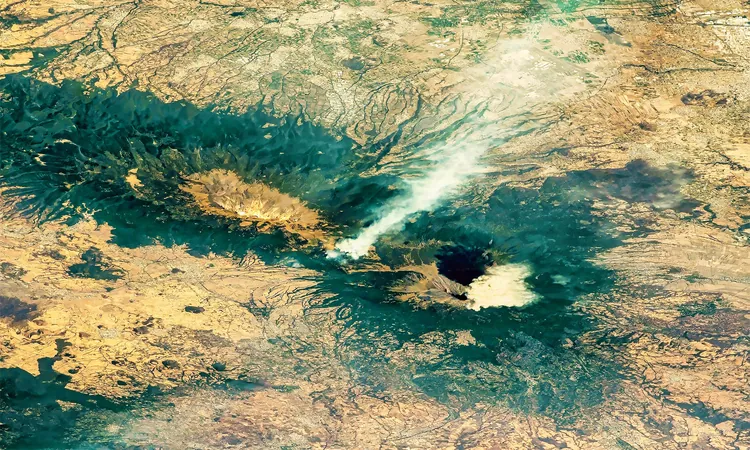
Can Vegetation Predict Volcano Eruptions? A Closer Look at Nature's Warning Signs
2025-01-02
Author: Nur
The Hidden Connection between Vegetation and Volcanic Activity
As magma surges upwards, it frequently releases gases like carbon dioxide. Although these gases are typically also present in our daily environment, significant changes in their levels can indicate imminent volcanic activity. For volcanoes located in remote areas, often devoid of permanent sensors, scientists are employing unconventional methods to monitor subtle changes in plant life that may serve as precursors to eruptions.
One pioneering study led by Robert Bogue from McGill University investigated vegetation health in the Yellowstone Caldera, focusing on patterns that could indicate volcanic unrest. The findings suggested that plants exhibit unique responses to their changing underground environments, which could signal the approach of an eruption.
How do Plants Reveal Subtle Signs?
Plants are remarkably adaptive; their growth patterns shift in reaction to changes in their environment. Variations in carbon dioxide, sulfur levels, and soil temperature play crucial roles in plant vitality. The ability of scientists to observe these responses is enhanced by satellite imagery, which can capture extensive areas and detect signs of stress—or unexpected growth—that may not be noticeable from the ground.
Using the Normalized Difference Vegetation Index (NDVI), researchers can analyze chlorophyll levels to gauge plant health. Scores from this index indicate the vigor of photosynthesis: higher numbers suggest healthier vegetation. By monitoring these indices over time, scientists can unveil patterns that correlate with movements occurring beneath the Earth’s crust.
Case Study: Tern Lake's Volcano Watching
One revealing case comes from the Tern Lake thermal area within the Yellowstone Caldera. Researchers tracked changes in vegetation from 1984 to 2022 through archived Landsat images. For an impressive 16 years, tree health improved in this hydrothermal area, possibly due to nutrient-rich soil. However, a downward shift began around the early 2000s, indicating a transition to environmental stress where lodgepole pines struggled to survive as soil temperatures soared above 122°F, coupled with increases in toxic gases.
As the detrimental effects spread, a previously verdant zone turned barren. Collectively, these observations indicated that a deeper installation process was heating the ground, altering essential soil chemistry.
Alert from Nature: The Early Warning System?
The connections made between these environmental indicators and subterranean movements are compelling. Earthquake activity often signals magma pushing through, indicating that volcanic systems can be in motion long before conventional monitoring tools capture them. Current research even hints at signs of recovery, with new plant life appearing in previously devastated areas, suggesting a possible return to stability.
Vegetation monitoring is proving to be an indispensable tool in assessing volcanic threats. While traditional sensors may face challenges in remote or hostile environments, analyzing plant growth can provide a low-tech yet insightful alternative. Vegetation indices and satellite imagery combined with data on minor quakes and gas composition could eventually help anticipate eruptions with increased accuracy.
Towards a Safer Future
Amidst the vastness of Earth's diverse ecosystems, the potential for plants to act as messengers of geological turmoil offers a fascinating avenue for research. However, it's crucial to acknowledge that context matters. While markers from vegetation can be insightful, external factors like drought or forest fires may obscure or mislead interpretations.
By synergizing observations from plant life with other geological signals, scientists aim to enhance eruption prediction capabilities. The hope is that by refining these techniques, we can improve safety measures for communities living near volcanoes, potentially issuing timely warnings to save lives.
Every volcano tells a story—by learning to understand these stories through the lens of nature, we may be able to prevent future catastrophes. This ongoing research not only enriches our understanding of geology but also solidifies the bond between the Earth’s processes and biological life, paving the way for a safer tomorrow.
The full study was published in the journal *Geochemistry, Geophysics, Geosystems*, showcasing nature’s incredible ability to act as an early warning system.

 Brasil (PT)
Brasil (PT)
 Canada (EN)
Canada (EN)
 Chile (ES)
Chile (ES)
 Česko (CS)
Česko (CS)
 대한민국 (KO)
대한민국 (KO)
 España (ES)
España (ES)
 France (FR)
France (FR)
 Hong Kong (EN)
Hong Kong (EN)
 Italia (IT)
Italia (IT)
 日本 (JA)
日本 (JA)
 Magyarország (HU)
Magyarország (HU)
 Norge (NO)
Norge (NO)
 Polska (PL)
Polska (PL)
 Schweiz (DE)
Schweiz (DE)
 Singapore (EN)
Singapore (EN)
 Sverige (SV)
Sverige (SV)
 Suomi (FI)
Suomi (FI)
 Türkiye (TR)
Türkiye (TR)
 الإمارات العربية المتحدة (AR)
الإمارات العربية المتحدة (AR)